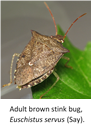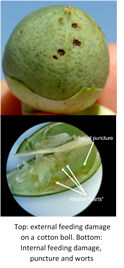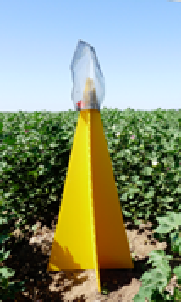Entomologist, Dr. Vonny Barlow of the University Cooperative Extension is in the process of continuing his research with Euschistus servus, or Brown Stink Bug (BSB),in cotton. Results from Barlows' studies have contributed to more effective management of BSB in Southern California.


In the eastern states, primarily Georgia, boll rot and cotton staining created by the BSB has become a substantial issue. Initially there was fear that BSB and associated boll rot could cause significant cotton losses in California which prompted many to make chemical applications. In fact, these chemical applications exceeded the regular 3-4 insecticide applications every season, sometimes substantially.
Dr. Barlow is currently in the second year of his experiment which he began over 1 month earlier than in 2015. Three commercial cotton fields were selected to establish experimental plots. Among the three fields, sixteen sampling 
At each sampling locations three data points are gathered. The first data sampling consisted of recording the number of BSB taken from each pheromone trap every seven days. Next, sweep samples consisting of 20 sweeps per trap location are collected and sorted in the laboratory for total numbers of BSB. Finally, stink bug damage to cotton bolls is assessed with 10 cotton bolls per each trap location selected and taken to the lab were they are “cracked”, and processed for; external and internal feeding punctures, stained cotton lint and presence of boll rot. By the end of the season we will have hand processed over 7,000 cotton bolls for this project.
The results of the experiment during the first year demonstrated that there is no significant aggregation of BSB along cotton field perimeters, contradicting what was previously predicted. Pheromone traps yielded greater stink bug numbers than sweep sampling over the same time period. However, the use of pheromone trapping is intensively laborious. It was also demonstrated that the use of 20% internal boll “warts” was not a useful indicator for “triggering” a chemical applications since it was shown that there is no relationship between presence of internal boll warts and cotton boll rot. It appears that even though boll warts when present, are not a “pathway” for bacteria that causes boll rot in Southern California. This may be due to the sometimes harsh environment of California's southern desert which may make the cotton plant leaf surface inhospitable to bacteria. Altogether these findings suggest that insecticide applications for the BSB in Southern California does not need to take place, saving growers from costly applications every season.